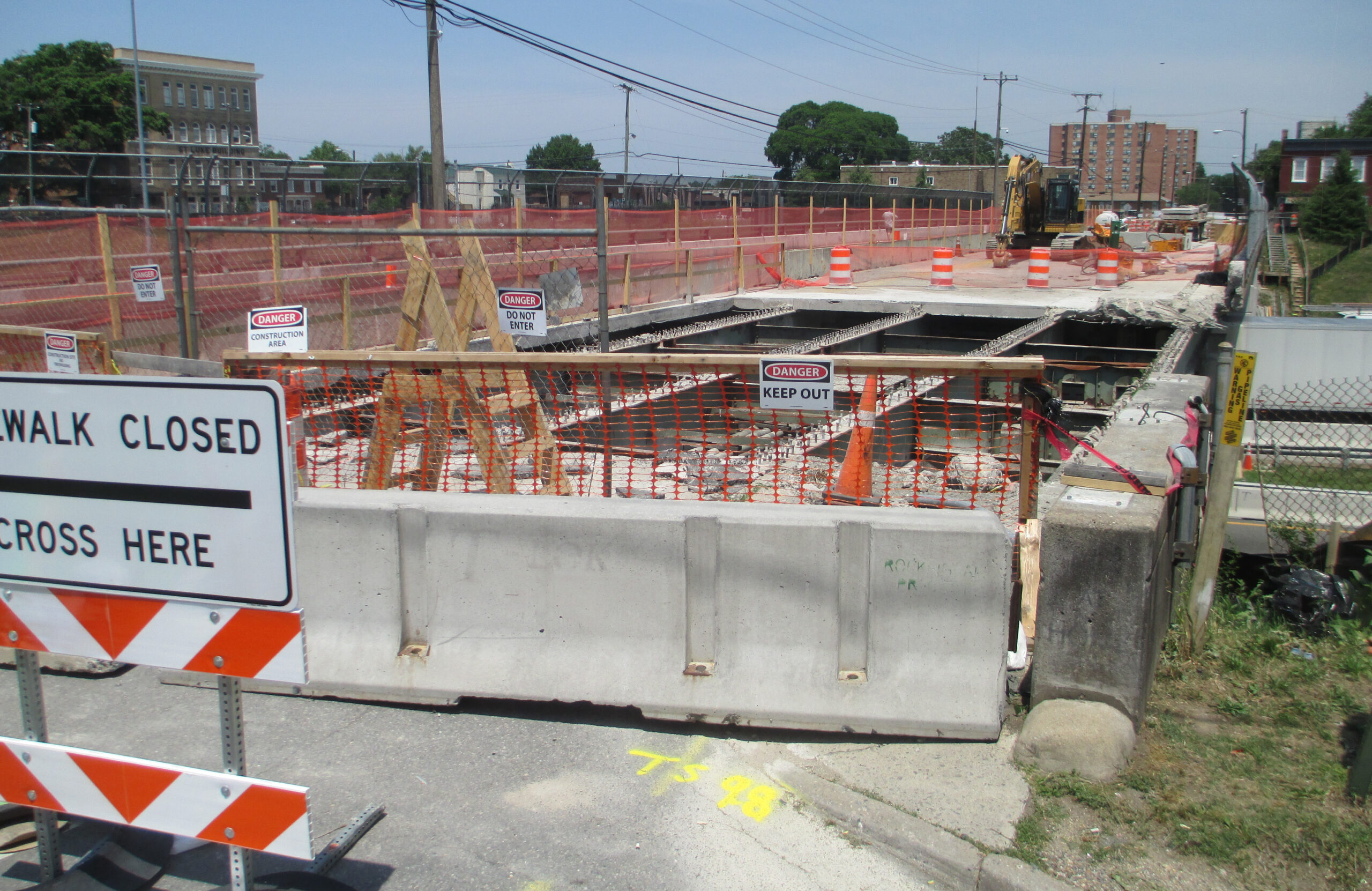
VDOT is rehabbing the First Street bridge, one of three road crossings connecting Jackson Ward. Traffic on the bridge is currently restricted to one southbound lane. (Photos by Jonathan Spiers)
With repairs underway to one of the only existing connections linking the Jackson Ward area across Interstate 64-95, a larger effort is being rolled out to further reconnect the neighborhood that the highway cut in half.
The City of Richmond and other agencies recently began outreach to develop a community plan for the historically black neighborhood. That coincides with the related “Reconnect Jackson Ward” study that’s weighing options for improving connections across the highway, which divided the neighborhood once known as Black Wall Street and the Harlem of the South when it was built in the 1950s.
Today, the only connections across the interstate east of the Belvidere Street interchange are bridge crossings at First Street, Fifth Street and Chamberlayne Parkway. The most central of those crossings, the First Street bridge, is for now less crossable due to an ongoing rehab of the structure that will increase its vertical clearance to reduce bridge strikes from tractor-trailers passing underneath.
The rehab is part of a multi-bridge project by the Virginia Department of Transportation. Other bridges on that project list include: the Fifth Street bridge that connects with Third and Fourth streets near Jackson Ward’s eastern end; the adjacent bridge for I-64 traffic entering downtown or merging onto I-95 South; the nearby Seventh Street bridge; and the East Broad Street crossing over I-95.
With that work ongoing, city planners and consultants are pushing forward with the Reconnect Jackson Ward study, which stems from recommendations in the Richmond 300 master plan that include a city-block-sized bridge deck in the area of First Street, similar to the Kanawha Plaza deck above the Downtown Expressway.
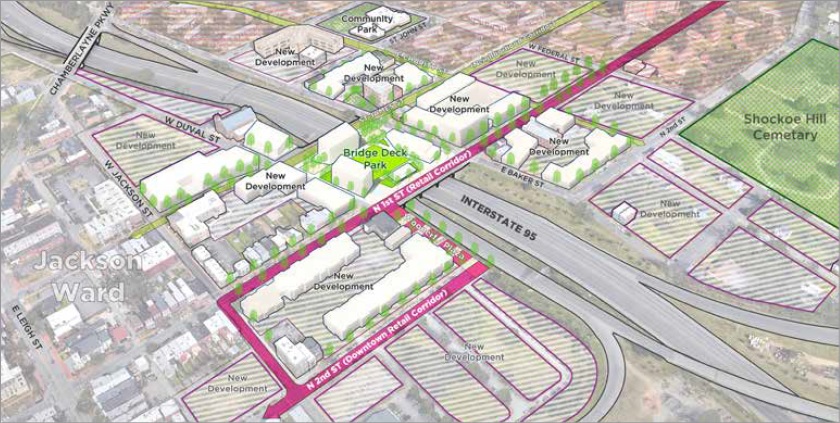
A rendering of the Jackson Ward bridge deck over the interstate recommended in the Richmond 300 plan.
Concepts displayed at a recent meeting showed one or more decks above the interstate between First Street and Chamberlayne Parkway. Similar projects have been done across the country, including in Seattle, Dallas and Columbus, Ohio.
The study kicked off in January to determine the feasibility of the bridge deck concept and other potential reconnection options, with community input and ideas factored in. Public meetings and informational events have been held since, and a community survey can be taken via the study’s website.
Maritza Pechin, a deputy director with the city planning office who’s guiding the effort, said the study aims to find the most feasible and quickly accomplishable project to improve connections for the neighborhood.
In a presentation this month to the Richmond Planning Commission, Pechin said, “Maybe we have a grand vision for lots of connection, but what we’re trying to do with the feasibility study is figure out what would be the first chunk that we could undertake sooner and be competitive for an application for federal funding.”
Pechin said a conceptual rendering and cost estimate for a potential connection project could be presented by June, setting the stage for the city to apply for federal funding through the $1 billion Reconnecting Communities grant program under the Infrastructure Investment and Jobs Act.
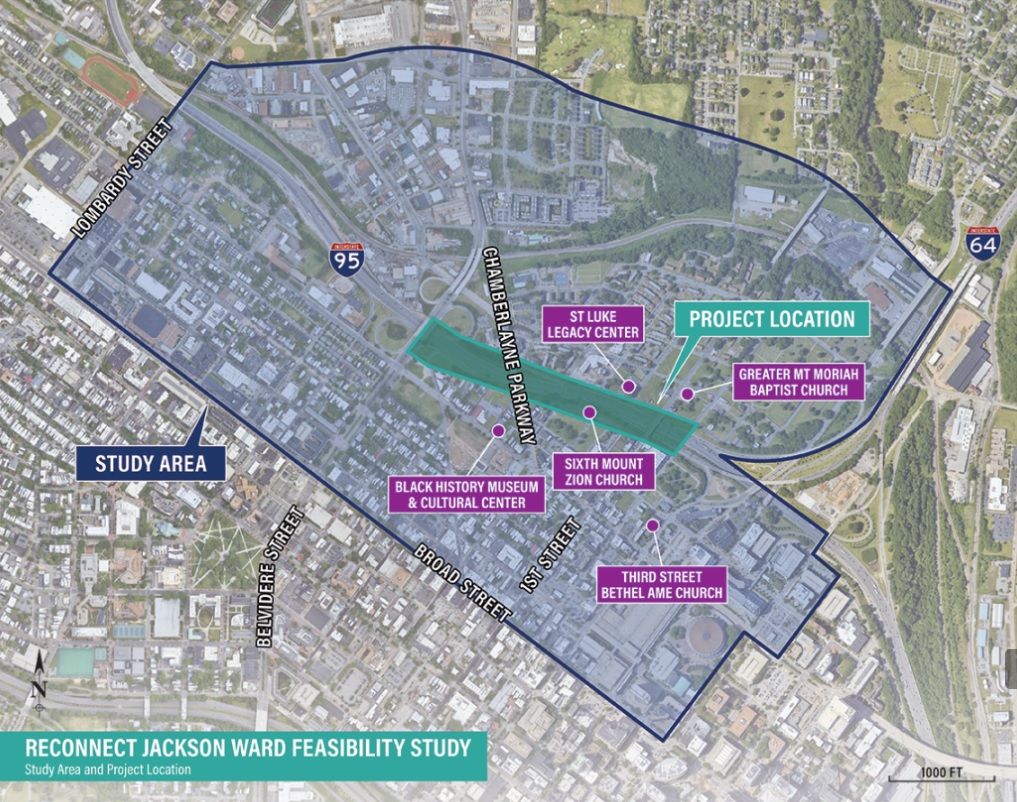
A map of the Reconnect Jackson Ward study area, which extends beyond the neighborhood. (City of Richmond image)
The feasibility study is being funded with $825,000 that the city was awarded by the Office of Intermodal Planning and Investment, under the Virginia Secretary of Transportation office. The funds cover community engagement and assistance in applying for the federal funding that’s expected to become available next month.
Plan would map out Gilpin Court redevelopment
At the same time, the city has launched a community outreach effort that’s kicking off the Jackson Ward community plan, which would guide development in the neighborhood as an amendment to Richmond 300 and help align various projects that are currently underway or in the pipeline.
The city is working with the Richmond Redevelopment & Housing Authority, Richmond City Health District and Storefront for Community Design on the planning effort, which is funded by a $450,000 grant awarded in November through the U.S. Department of Housing and Urban Development’s Choice Neighborhoods program.
RRHA was the lead applicant for that grant and had previously enlisted LRK, a planning consultancy based in Philadelphia that’s now assisting with the plan.
A major component of the plan would be a phasing strategy for how RRHA would redevelop Gilpin Court, the 780-unit public housing complex that has come to largely define the north side of Jackson Ward. The city started building the complex in the 1940s, before what was then called the Richmond-Petersburg Turnpike cut a swath through the center of Jackson Ward.
While the plan would not produce new housing on its own, Pechin said it would show a path for going about it, positioning the agencies to apply for an implementation grant through the Neighborhoods Choice program.
“You don’t always get both. It’s actually kind of rare, but we’re still going to try,” Pechin said. She added that an implementation grant would only cover a portion of what’s laid out in the plan and would require completion of the work it is funding within five years.
Pechin said the planning effort for Gilpin and Jackson Ward should not be compared with the revitalization effort underway at Creighton Court, where a one-for-one replacement of 504 units is planned along with 1,000 new homes for lower-income residents, adding to the massive Armstrong Renaissance development nearby.
“That was all implementation. This is preparing to build things,” Pechin said of the Jackson Ward plan. “It’s a really good opportunity to align a lot of the stuff that has been happening in Gilpin.”
Multiple projects underway
Pechin noted some projects have already started the process, such as RRHA’s recently completed collaboration with Enterprise Community Development to relocate senior residents from Gilpin’s Fay Towers, and Charley Ayers’ redevelopment of the St. Luke Building with plans for 120 more apartments nearby. Work has also started on Better Housing Coalition’s 67-unit apartment building south of the interstate.
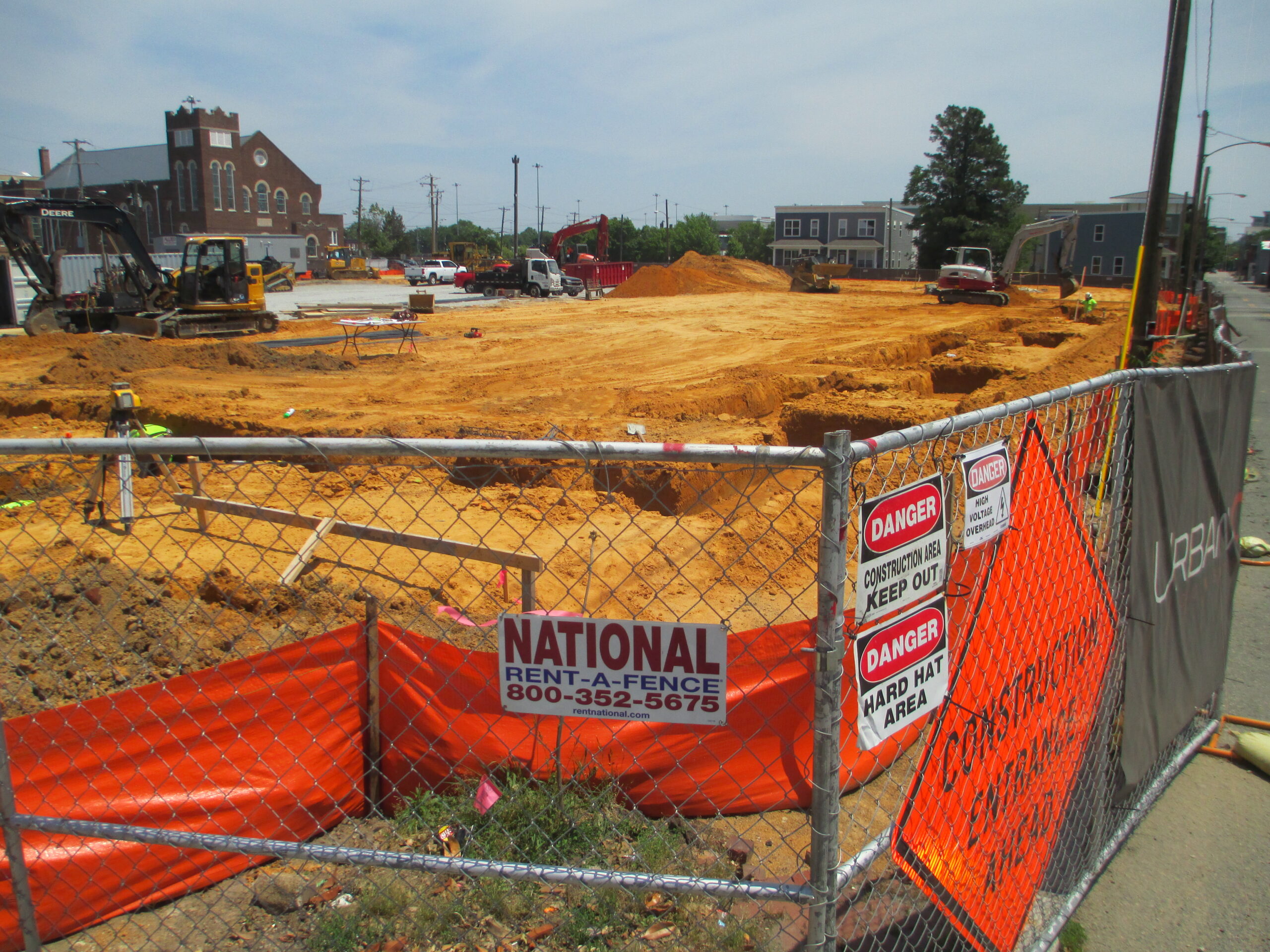
Work has started on Better Housing Coalition’s 67-unit apartment building that will fill the city block bordered by Cameo, Jackson, Price and Duval streets.
Pechin also noted more than a dozen other projects that the plan would ideally help to coordinate. The projects are listed on the plan’s webpage and include the First Street bridge rehab, a VDOT study for reconstructing the Belvidere interchange, planned improvements to Gilpin’s Calhoun Center and Calhoun Park, and a public art installation nearby.
Others include the Shockoe Hill African Burial Ground site, a 1.2-acre portion of which the city purchased last year and is planning archaeological research and commemoration; The JXN Project’s plan to recreate the Skipwith-Roper Cottage, the neighborhood’s first known black-owned home; and a proposed design overlay district and expansion of the Jackson Ward Old and Historic District.
“One of the exciting things is there is so much happening,” Pechin said in her presentation. “I’m thrilled that we won the Choice Neighborhoods planning grant, because it means that we have the capacity and the expertise from LRK to help us align everything in conjunction with the redevelopment of Gilpin Court.”
Outreach efforts underway include targeted engagement with Gilpin residents as well as the larger community. The Choice Neighborhoods grant requires a survey with at least 60 percent participation among Gilpin households. That survey is also available on the plan webpage.
A Gilpin meeting and community expo were held this month, and additional meetings are scheduled June 14 at Fay Towers and June 16 at Gallery5, both at 6 p.m.
Pechin said the agencies are aiming to have a draft plan complete by May 2023, with adoption and implementation targeted for early 2024.
While the spirit of the plan is to reconnect and revive both halves of Jackson Ward, Pechin said care is being taken to refer to the neighborhood as a whole rather than two separate areas.
“One thing that we’re very cognizant of saying is this is all Jackson Ward,” Pechin said. “It’s not Jackson Ward/Gilpin Court, it’s not North Jackson Ward, it’s not South Jackson Ward; it’s all Jackson Ward.”

VDOT is rehabbing the First Street bridge, one of three road crossings connecting Jackson Ward. Traffic on the bridge is currently restricted to one southbound lane. (Photos by Jonathan Spiers)
With repairs underway to one of the only existing connections linking the Jackson Ward area across Interstate 64-95, a larger effort is being rolled out to further reconnect the neighborhood that the highway cut in half.
The City of Richmond and other agencies recently began outreach to develop a community plan for the historically black neighborhood. That coincides with the related “Reconnect Jackson Ward” study that’s weighing options for improving connections across the highway, which divided the neighborhood once known as Black Wall Street and the Harlem of the South when it was built in the 1950s.
Today, the only connections across the interstate east of the Belvidere Street interchange are bridge crossings at First Street, Fifth Street and Chamberlayne Parkway. The most central of those crossings, the First Street bridge, is for now less crossable due to an ongoing rehab of the structure that will increase its vertical clearance to reduce bridge strikes from tractor-trailers passing underneath.
The rehab is part of a multi-bridge project by the Virginia Department of Transportation. Other bridges on that project list include: the Fifth Street bridge that connects with Third and Fourth streets near Jackson Ward’s eastern end; the adjacent bridge for I-64 traffic entering downtown or merging onto I-95 South; the nearby Seventh Street bridge; and the East Broad Street crossing over I-95.
With that work ongoing, city planners and consultants are pushing forward with the Reconnect Jackson Ward study, which stems from recommendations in the Richmond 300 master plan that include a city-block-sized bridge deck in the area of First Street, similar to the Kanawha Plaza deck above the Downtown Expressway.

A rendering of the Jackson Ward bridge deck over the interstate recommended in the Richmond 300 plan.
Concepts displayed at a recent meeting showed one or more decks above the interstate between First Street and Chamberlayne Parkway. Similar projects have been done across the country, including in Seattle, Dallas and Columbus, Ohio.
The study kicked off in January to determine the feasibility of the bridge deck concept and other potential reconnection options, with community input and ideas factored in. Public meetings and informational events have been held since, and a community survey can be taken via the study’s website.
Maritza Pechin, a deputy director with the city planning office who’s guiding the effort, said the study aims to find the most feasible and quickly accomplishable project to improve connections for the neighborhood.
In a presentation this month to the Richmond Planning Commission, Pechin said, “Maybe we have a grand vision for lots of connection, but what we’re trying to do with the feasibility study is figure out what would be the first chunk that we could undertake sooner and be competitive for an application for federal funding.”
Pechin said a conceptual rendering and cost estimate for a potential connection project could be presented by June, setting the stage for the city to apply for federal funding through the $1 billion Reconnecting Communities grant program under the Infrastructure Investment and Jobs Act.

A map of the Reconnect Jackson Ward study area, which extends beyond the neighborhood. (City of Richmond image)
The feasibility study is being funded with $825,000 that the city was awarded by the Office of Intermodal Planning and Investment, under the Virginia Secretary of Transportation office. The funds cover community engagement and assistance in applying for the federal funding that’s expected to become available next month.
Plan would map out Gilpin Court redevelopment
At the same time, the city has launched a community outreach effort that’s kicking off the Jackson Ward community plan, which would guide development in the neighborhood as an amendment to Richmond 300 and help align various projects that are currently underway or in the pipeline.
The city is working with the Richmond Redevelopment & Housing Authority, Richmond City Health District and Storefront for Community Design on the planning effort, which is funded by a $450,000 grant awarded in November through the U.S. Department of Housing and Urban Development’s Choice Neighborhoods program.
RRHA was the lead applicant for that grant and had previously enlisted LRK, a planning consultancy based in Philadelphia that’s now assisting with the plan.
A major component of the plan would be a phasing strategy for how RRHA would redevelop Gilpin Court, the 780-unit public housing complex that has come to largely define the north side of Jackson Ward. The city started building the complex in the 1940s, before what was then called the Richmond-Petersburg Turnpike cut a swath through the center of Jackson Ward.
While the plan would not produce new housing on its own, Pechin said it would show a path for going about it, positioning the agencies to apply for an implementation grant through the Neighborhoods Choice program.
“You don’t always get both. It’s actually kind of rare, but we’re still going to try,” Pechin said. She added that an implementation grant would only cover a portion of what’s laid out in the plan and would require completion of the work it is funding within five years.
Pechin said the planning effort for Gilpin and Jackson Ward should not be compared with the revitalization effort underway at Creighton Court, where a one-for-one replacement of 504 units is planned along with 1,000 new homes for lower-income residents, adding to the massive Armstrong Renaissance development nearby.
“That was all implementation. This is preparing to build things,” Pechin said of the Jackson Ward plan. “It’s a really good opportunity to align a lot of the stuff that has been happening in Gilpin.”
Multiple projects underway
Pechin noted some projects have already started the process, such as RRHA’s recently completed collaboration with Enterprise Community Development to relocate senior residents from Gilpin’s Fay Towers, and Charley Ayers’ redevelopment of the St. Luke Building with plans for 120 more apartments nearby. Work has also started on Better Housing Coalition’s 67-unit apartment building south of the interstate.

Work has started on Better Housing Coalition’s 67-unit apartment building that will fill the city block bordered by Cameo, Jackson, Price and Duval streets.
Pechin also noted more than a dozen other projects that the plan would ideally help to coordinate. The projects are listed on the plan’s webpage and include the First Street bridge rehab, a VDOT study for reconstructing the Belvidere interchange, planned improvements to Gilpin’s Calhoun Center and Calhoun Park, and a public art installation nearby.
Others include the Shockoe Hill African Burial Ground site, a 1.2-acre portion of which the city purchased last year and is planning archaeological research and commemoration; The JXN Project’s plan to recreate the Skipwith-Roper Cottage, the neighborhood’s first known black-owned home; and a proposed design overlay district and expansion of the Jackson Ward Old and Historic District.
“One of the exciting things is there is so much happening,” Pechin said in her presentation. “I’m thrilled that we won the Choice Neighborhoods planning grant, because it means that we have the capacity and the expertise from LRK to help us align everything in conjunction with the redevelopment of Gilpin Court.”
Outreach efforts underway include targeted engagement with Gilpin residents as well as the larger community. The Choice Neighborhoods grant requires a survey with at least 60 percent participation among Gilpin households. That survey is also available on the plan webpage.
A Gilpin meeting and community expo were held this month, and additional meetings are scheduled June 14 at Fay Towers and June 16 at Gallery5, both at 6 p.m.
Pechin said the agencies are aiming to have a draft plan complete by May 2023, with adoption and implementation targeted for early 2024.
While the spirit of the plan is to reconnect and revive both halves of Jackson Ward, Pechin said care is being taken to refer to the neighborhood as a whole rather than two separate areas.
“One thing that we’re very cognizant of saying is this is all Jackson Ward,” Pechin said. “It’s not Jackson Ward/Gilpin Court, it’s not North Jackson Ward, it’s not South Jackson Ward; it’s all Jackson Ward.”
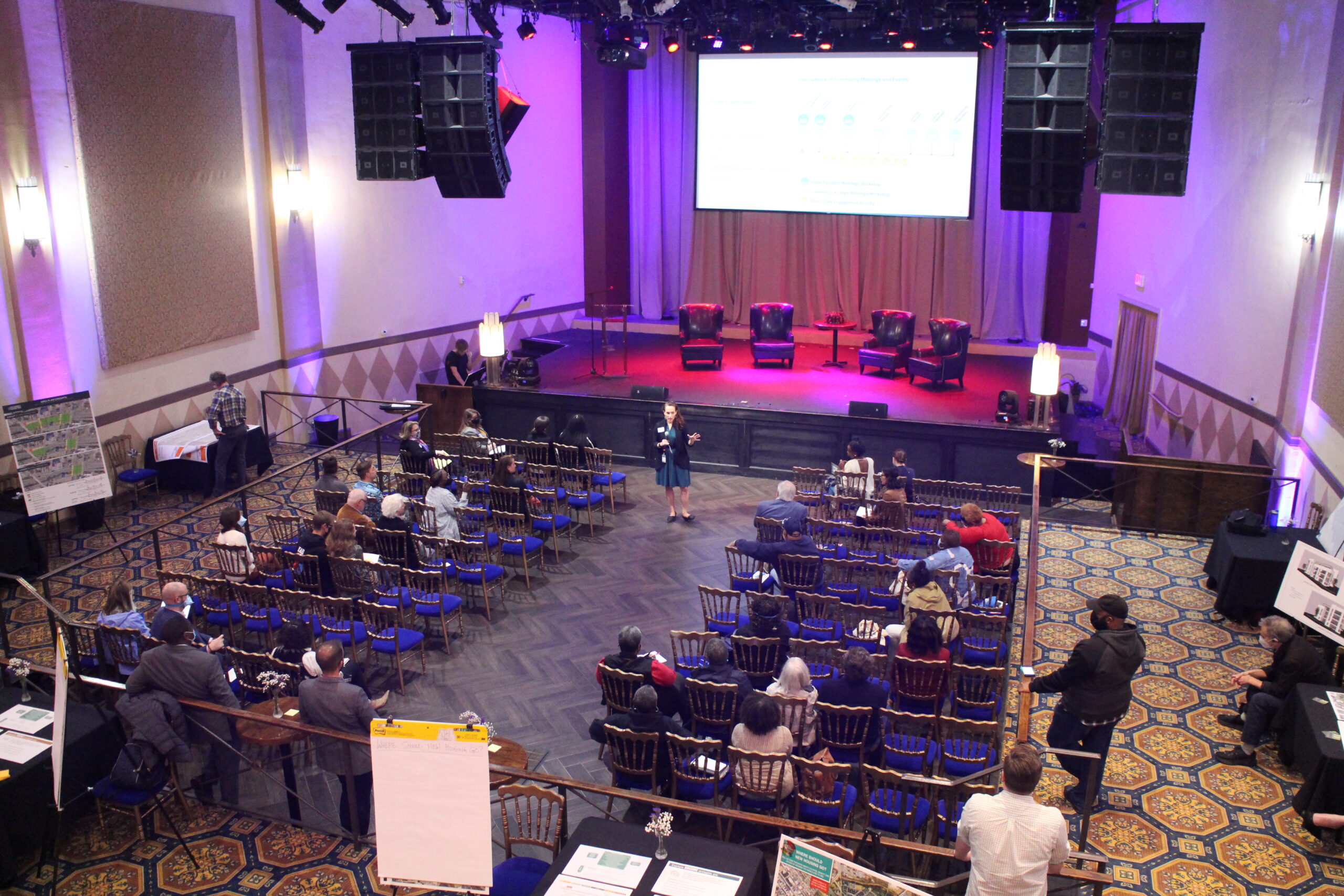
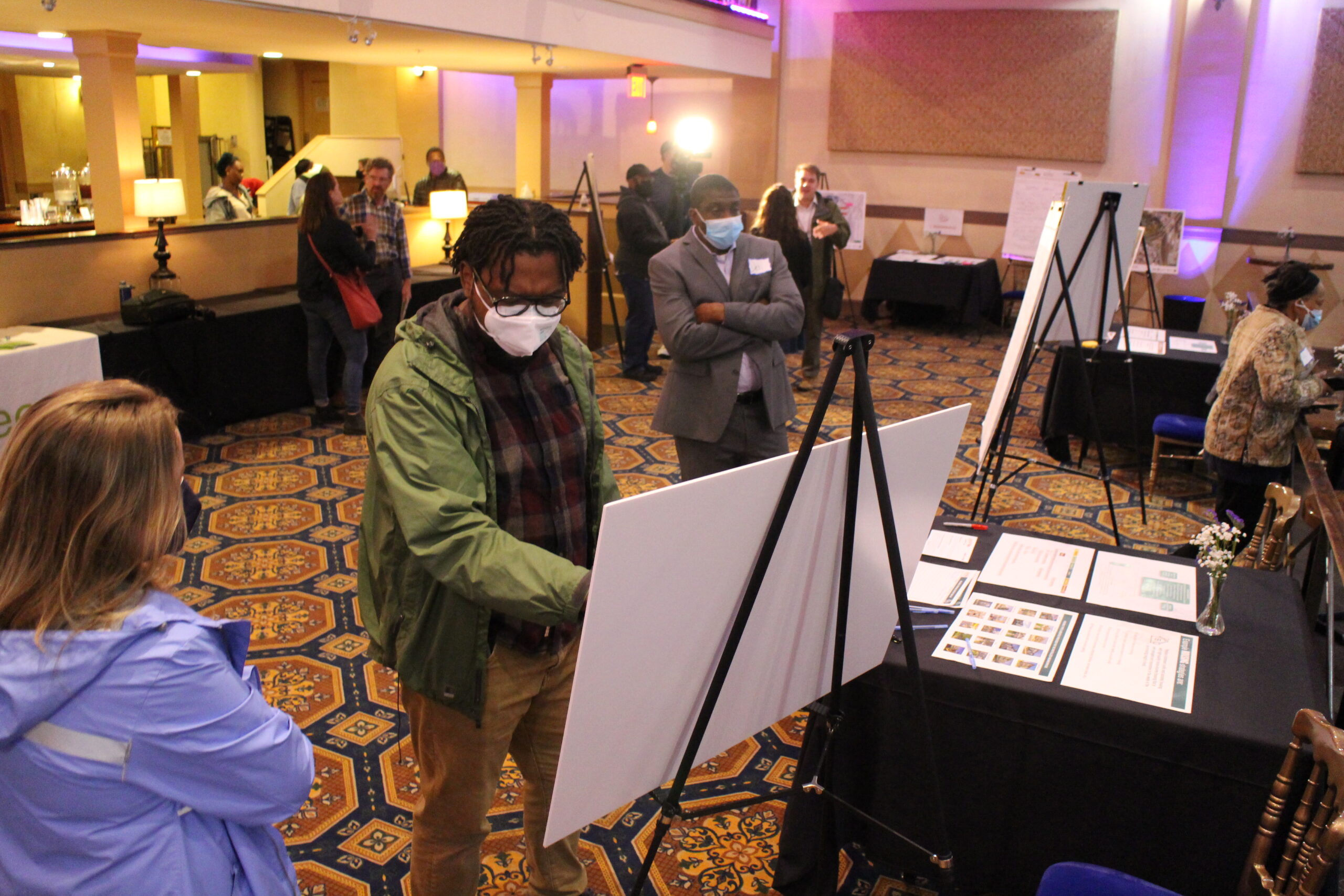
That’s cute. Meanwhile our park that underwent a complete reconstruction, Abner Clay Park, is still in dissaray. We have a moat around the sidewalk, lack grass, have an uneven football field goal post, uneven dangerous blacktop for a basketball court, and much more. Only cost us 10 years of begging the City to fulfill their “promise” and $1 million, including $100,000+ to the Timmons Group so they could design a very plain worse now than it was park.
I love that a full plaza-size “bridge” is to be built over I-95 reconnecting the two sides of this “paved river” thru the city. It’s good to see them being built nation-wide.
I would be nice if they could connect ever part over 95, 64, 195 that could accommodate a deck build over to reconnect those city neighborhoods together as a whole.
Convert all highways into tunnels?
Who benefits from all of this construction and planning? Nowhere do I see a new school for this amazing section of the city. Do the city leaders not consider the youth? Have they no value in education? Until I see them making a concerted effort to put the children first, I will not give a hoot about their trendy plans that appear to benefit whom? My guess is property owners. This section of Richmond is surrounded by VCU, VUU, MCV, Virginia State Library, City Hall(ugh), State Capital and no K-12 schools other than the non-locals at Maggie Walker. If you… Read more »
How are we supposed get sustainable investment for our schools without rebuilding and reconnecting neighborhoods decimated by decades of systemic marginalization? Ideally, the city would be working towards both long-term economic solutions, and immediate budget increases for RPS infrastructure. Unfortunately, I don’t believe you can really have one without the other. What I do not think is useful, is the perpetual hand-wringing over every decision the city takes under the “What About The Children?!?!” pretense. These are wholly different budgetary silos, and this narrative has become a tired straw man used against any cursory effort towards all sorts of developments… Read more »
Fully agreed. Well said!
Your “systemic marginalization” (whatever that means?) was mostly self-inflicted. Jackson Ward was doing fine until many of the residents perceived their civil rights meant they could move to nicer neighborhoods or shop at the malls all the while leaving local merchants dry, forcing them to close. Houses became neglected, left to those who could least afford to maintain them. The neighborhood’s Consolidated Bank was forced to close for lack of support because the people took their funds to the big corporate banks. This was a vibrant city neighborhood that didn’t care and left its past behind.
Bartholemew’s red-lining and subsequent devaluation of Black-owned properties across Richmond in the 1940s, and the later unfulfilled promises of urban renewal in the 1960s and 70s is hardly what I would consider a “self-inflicted” inside job…
I have no idea who Bartholemew is…but that does not put me behind the 8-ball. Richmond changed quite a bit during the 60’s/70’s with the coliseum, new City Hall, new Federal Reserve bldg. Azalea Mall, new Vepco bldg. revitalized Shockoe Slip, new downtown bank bldgs. and the Powhite Parkway, I-64, and Manchester Bridge to name a few. The worst of all gov’t intrusion was forced bussing. Big gov’t ideas are to be suspicious at best. President Reagan once said, “The nine most feared words are. I’m from the government and I’m here to help.” Put that in your systemic pipe… Read more »
Red-lining was real and a bad practice. Yet another reason why I-95 being built 30 years later was not the thing that destroyed the middle class in JW. How will building a park over part I-95 undo that practice implemented by people who died long ago?
Good question.
The premise that I-95 is the source of all problems in North Jackson Ward is absurd. Where is the evidence? Construction of the highway occurred just after the passage and the Civil Right Act. The biggest change in the quality of life, were the professionals, strong families and well educated residents who left for the suburbs and better schools. Those left behind in deteriorating schools, less friendly service providers and still racist government officials suffered. Many of those former residents became slumlords in them area and took advantage of the declining real estate prices. Yes, blocks of the neighborhoods were… Read more »